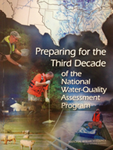The USGS National Water-Quality Assessment (NAWQA) Program has released a revised September 2013 update to an earlier report addressing the prioritization of constituents to be assessed when evaluating water and sediment quality. Entitled, "Prioritization of Constituents for National and Regional Scale Ambient Monitoring of Water and Sediment in the United States," the report describes a tiered prioritization approach that can be used by water resource managers when selecting chemicals to be included in ambient water and sediment quality monitoring strategies. Over 2,500 chemicals were prioritized by a NAWQA National Target Analyte Strategy Work Group based on physical and chemical properties, observed and predicted environmental occurrence and fate, and observed or anticipated adverse health or environmental effects. 1,081 of the constituents evaluated were determined to be of highest priority for ambient monitoring.
The constituents prioritized for this effort included various types of organic compounds, trace elements and other inorganic constituents, and radionuclides, and were placed into three tiers:
Tier 1: those having the highest priority on the basis of their likelihood of environmental occurrence in ambient water or sediment, or likelihood of effects on human health or aquatic life;
Tier 2: those of intermediate priority on the basis of their lower likelihood of environmental occurrence or lower likelihood of effects on human health or aquatic life; and
Tier 3: those with low or no priority for monitoring.
This effort was undertaken in preparation for the upcoming third decade of the NAWQA Program (2013-2023).

No comments:
Post a Comment